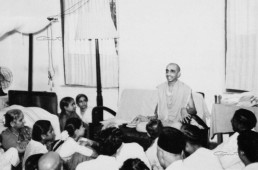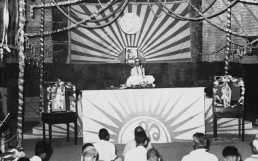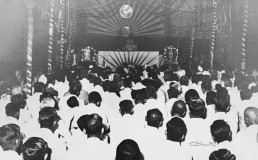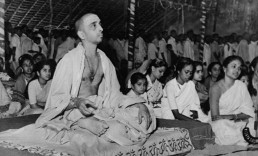
Jnana Yajna 30

Year & Dates:
May 01, 1957 to May 31, 1957

Yajna Topic:
Mundakopanishad

Place:
Bengaluru, India.
“The Upanishad Jnana Yajna is a determined pilgrimage to Truth,” said Sri. A.G. Ramachandra Rao, Ex.Education Minister, Mysore State, and President of the Upanishad Jnana Yajna Committee as he welcomed an exuberant, elite audience of over three thousand on May 1, 1957 at City Institute Premises, Chamarajpet. His Highness Jayachamarajendra Wadiyar, the Maharaja and Governor of Mysore, in his inaugural address, expressed: “I have great pleasure in inaugurating this Jnana Yajna, the Great Ritual of spreading enlightenment and happiness, contentment, goodness, and contact with the True (Santosha, Santripti, Sadaachaara, and Satsanga) which are announced by Swamiji to be the aims of his great Mission. Let us pray and hope that the Flame of Truth that is now lit up will be ever kept burning.”
All-day, Always Spiritual Stamina
“The same old Chinmaya minus the beard,” Pujya Gurudev introduced Himself with His charming smile. He advised: “A revival of the Upanishad studies would at this moment give us the necessary stamina to keep us within the pattern of the Hindu thoughts – in short will give our momentous progress a direction and glorious goal.”
For that Supreme Goal to be within everyone’s reach, Pujya Gurudev made Himself available all through the day. His typical day was a dynamic flow of knowledge. Starting at 5 am until 6:30 am, He conducted classes for the seekers in National College, Bengaluru, on the minor works of Shri Aadi Shankara. From 7:30 – 10 am, He taught Atma Bodha at the Yajnashala pandal. Before His evening discourses on Mundakopanishad, He planned the upcoming yajnas and attended meetings, also making time for the unending questions from the crowd that always followed Him. The QA sessions sometimes lasted until midnight! Amazingly, Pujya Gurudev came to every session and met each devotee with His characteristic electrifying energy, clarity, attention, boundless compassion, and love. Needless to say, the Knowledge of all branches of knowledge that Mundakopanishad enshrined shone bright and lustrous in that triumphant Jnana Yajna.
Photo Gallery

“Think,” Says Pujya Gurudev
In Vedanta, this idea is explained by means of an analogy of a piece of cloth in which some patterns and forms are woven in by the same thread as of the cloth. So long as the cloth is observed as such, the names and forms represented in it are true and real. But when we draw out the thread we find that all the names and forms merge themselves to form a bundle of threads; and if the threads are unwound, nothing remains but a quantity of cotton. In the final analysis, the names and forms on the piece of cloth, including the very cloth-piece, were nothing but a seeming transformation of the cotton-stuff.
Removing all the cotton, neither the cloth nor the pattern can remain. In cotton it exists, out of cotton it has come and into cotton alone can it merge back. Similarly the Pure Consciousness, the Eternal Pure Wisdom. Is That Knowledge, ‘knowing which every other knowledge becomes known’; out of this Absolute Knowledge has all the world of names and forms emerged, and in it they exist and into it they merge back.
From Mundakopanishad Yajna Prasad
An Allegory of Spiritual Awakening
Here we have the symbolic tale of the two birds, one of the most famous allegories of Mundakopanishad. These two birds represent the dual nature of the individual self and the eternal consciousness, let’s discover how redirecting focus from worldly pursuits to spiritual contemplation leads to inner tranquility and bliss.




